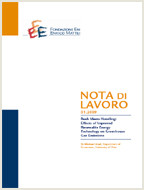REDD in the Carbon Market: A General Equilibrium Analysis

15.10.2010
Francesco Bosello, Fabio Eboli, Ramiro Parrado and Renato Rosa
D58, Q23, Q54
Forestry, Avoided Deforestation, Climate Change, Emission Trading, General Equilibrium Modelling
Climate Change and Sustainable Development
Carlo Carraro
Deforestation is a major source of CO2 emissions, accounting for around 17% of total annual anthropogenic carbon release. While the cost estimates of reducing deforestation rates vary considerably depending on model assumptions, it is widely accepted that emissions reductions from avoided deforestation consist of a relatively low cost mitigation option. Halting deforestation is therefore not only a major ecological challenge, but also a great opportunity to cost effectively reduce climate change negative impacts. In this paper we analyze the impact of introducing avoided deforestation credits into the European carbon market using a multiregional Computable General Equilibrium model – the ICES model (Inter-temporal Computable Equilibrium System). Taking into account political concerns over a possible “flooding” of REDD credits, various limits to the number of REDD allowances entering the carbon market are considered. Finally, unlike previous studies, we account for both direct and indirect effects occurring on land and timber markets resulting from lower deforestation rates. We conclude that avoided deforestation notably reduces climate change policy costs – by approximately 80% with unlimited availability of REDD credits – and may drastically reduce carbon prices. Policy makers may, however, effectively control for these imposing limits to avoided deforestation credits use. Moreover, avoided deforestation has the additional positive effect of reducing carbon leakage of a unilateral European climate change policy. This is good news for the EU, but not necessarily for REDD regions. Indeed we show that REDD revenues are not sufficient to compensate REDD regions for a less leakage-affected and more competitive EU in international markets. In fact, REDD regions would prefer to free ride on the EU unilateral mitigation policy.
***
Suggested citation: Francesco Bosello, Ramiro Parrado, Renato Rosa, Fabio Eboli, REDD in the Carbon Market: A General Equilibrium Analysis, Environmental Modeling & Assessment, April 2015, Volume 20, Issue 2, pp 103-115, http://rd.springer.com/article/10.1007%2Fs10666-014-9419-1
